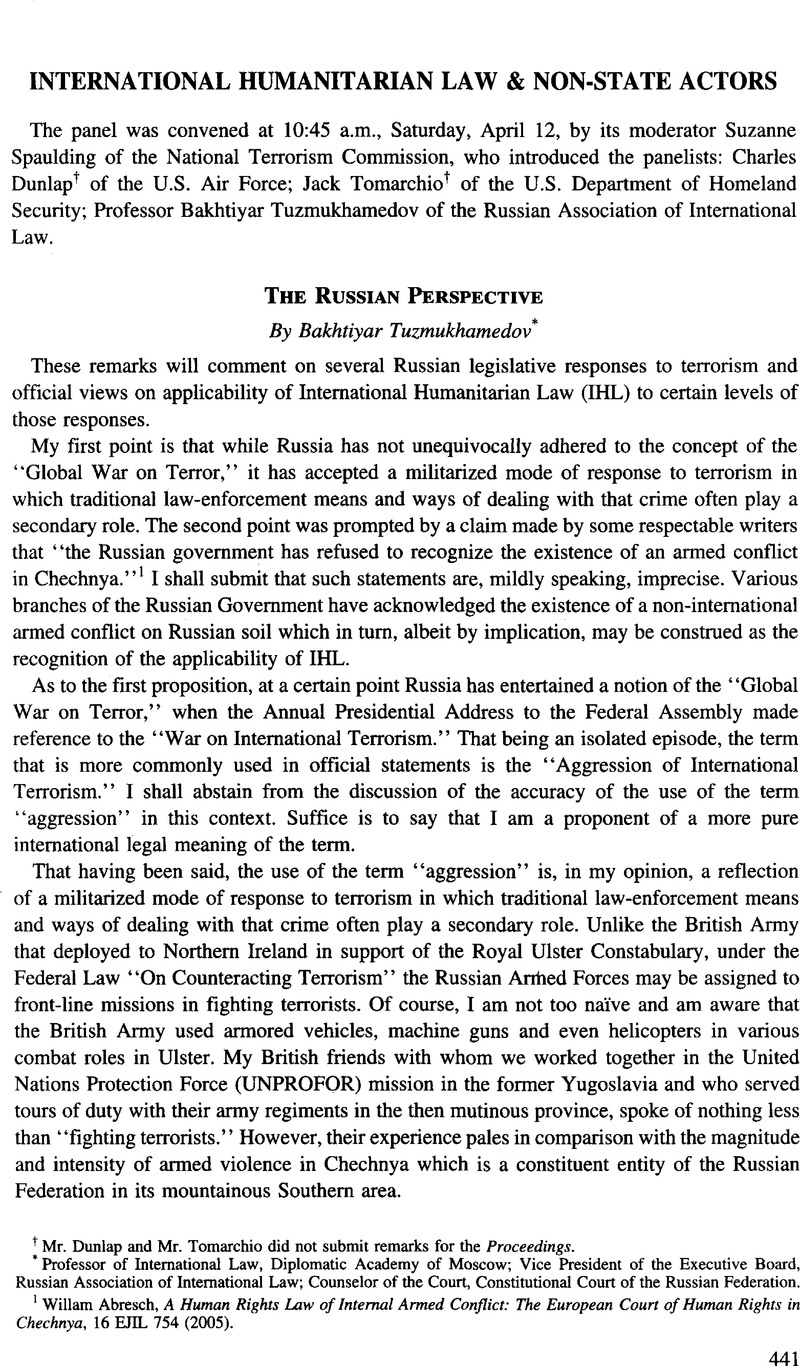Article contents
The Russian Perspective
Published online by Cambridge University Press: 28 February 2017
Abstract

- Type
- International Humanitarian Law & Non-State Actors
- Information
- Copyright
- Copyright © American Society of International Law 2008
References
† Mr. Dunlap and Mr. Tomarchio did not submit remarks for the Proceedings.
1 Abresch, Willam, A Human Rights Law of Internal Armed Conflict: The European Court of Human Rights in Chechnya, 16 EJIL 754 (2005)CrossRefGoogle Scholar.
2 Tuzmukhamedov, Bakhtiyar, Preemption by Armed Force of Transboundary Terrorist Threats: the Russian Perspective, in Global Legal Challenges: Command of the Commons, Strategic Communications and Natural Disasters (International Law Studies) (Carsten, Michael D. ed., 2007)Google Scholar.
3 Milanovic, Marko, Lessons for human rights and humanitarian law in the war on terror: comparing Hamdan and the Israeli Targeted Killings case, 866 Int’L Rev. Red Cross 380 (2007)Google Scholar.
4 On Additional Guarantees and Compensations for Military Service Personnel Serving on Territories of States of Trans-Caucasus, Baltic States, and the Republic of Tajikistan, and on Performing Assignments During the State of Emergency and in Armed Conflicts, Vedomosti S‘‘ezda Narodnykh Deputatov i Verkhovnogo Soveta Rossiiskoi Federatsii [Ved. RF] [Bulletin of the Congress of People’s Deputies and of the Supreme Soviet of the Russian Federation] 1993, No. 6, Item 181.
5 Federal Law of the Russian Federation, No. 75-FZ, Sobrante Zakonodate‘stva Rossiiskoi Federatsii [SZ RF] [Russian Federation Collection of Legislation] 1995, No. 21, Item 1923; see also Federal Law of the Russian Federation, No. 146-FZ, SZ RF 1997, No. 47, Item 5343 (emphasis added).
6 Fin. Times, Dec. 11, 1999.
7 Rossiyskaya Gazeta, Apr. 19, 2002.
8 See Prosecutor v. Tadić, Decision on the Defence Motion for Interlocutory Appeal on Jurisdiction, No. IT-94-1-T (Oct. 5, 1995), ¶ 70. The Chamber defined “armed conflict” as follows: “... an armed conflict exists whenever there is a resort to armed force between States or protracted armed violence between governmental authorities and organized armed groups or between such groups within a State. International humanitarian law applies from the initiation of such armed conflicts and extends beyond the cessation of hostilities until a general conclusion of peace is reached; or, in the case of internal conflicts, a peaceful settlement is achieved. Until that moment, international humanitarian law continues to apply in the whole territory of the warring States or, in the case of internal conflicts, the whole territory under the control of a party, whether or not actual combat takes place there.”
- 1
- Cited by


